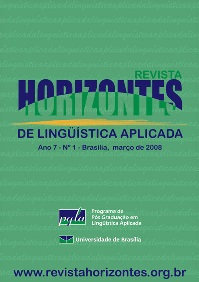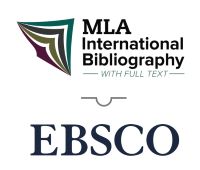The influence of a second language (L2) student’s goal on her attitudes and actions towards learning: a socio-cultural approach
DOI:
https://doi.org/10.26512/rhla.v7i1.604Palavras-chave:
Segunda língua (l2);, Redação em inglês;, Teoria da atividade;, Comportamento em sala de aula;, ObjetivosResumo
Esse artigo trata da relação entre os objetivos de uma aluna de inglês como segunda língua e suas atitudes e ações em relação ao seu aprendizado de como escrever redações argumentativas em inglês. Foi realizado um estudo de caso de uma estudante de nível intermediário num curso de redação em um instituto de línguas nos Estados Unidos. Dados foram coletados de redações escritas pela aluna, entrevistas, questionários, observações de sala de aula, diário do professor/pesquisador, e transcrição de atividades em pares. Os resultados do estudo mostraram que, apesar de existirem contradições entre as atitudes e ações positivas da aluna em sala de aula e seus sentimentos negativos quanto a escrever redações e a atividades desenvolvidas durante o curso, houve melhora na sua habilidade de escrever. A moldura sociocultural da teoria da atividade fornece esclarecimentos sobre o seu comportamento em aula: o seu objetivo geral ajudou-a a desprezar seu desgosto por escrever redações e pelas atividades de sala de aula para que pudesse melhorar a escrita em inglês. Sugere-se, pois, que os professores prestem atenção aos objetivos e comportamento dos seus alunos para que possam melhorar o processo de ensino-aprendizagem, adaptando a metodologia aos objetivos dos alunos.
Downloads
Referências
BANNON, Liam. Activity theory. 1997. Disponível em: http://www-sv.cict.fr/cotcos/pjs/TheoreticalApproaches/Actvity/ActivitypaperBannon.htm. Acesso em: 4 mar. 2005.
BREEN, Michael P. Learner contribution to task design. In: CANDLIN, Christopher N.; MURPHY, Dermot F. (Eds.). Language learning tasks. Lancaster practical papers in English language education, v. 7. Englewood Cliffs, NJ: Prentice-Hall International, 1987. p. 23-46.
BRYMAN, Alan. Social research methods. Oxford, UK: Oxford University Press, 2001.
BURNS, Robert B. Introduction to research methods. 3rd ed. Melbourne, Australia: Addison Wesley Longman, 1996.
COHEN, Andrew D.; DÖRNYEI, Zoltan. Focus on the language learner: motivation, styles and strategies. In: SCHMITT, Norbert. (Ed.). An introduction to applied linguistics. London, UK: Arnold, 2002. p. 170-190.
COHEN, Louis; MANION, Lawrence. Research methods in education. 4th ed. London, UK: Routledge, 1994.
COUGHLAN, Peter; DUFF, Patricia A. Same task, different activity: analysis of SLA task from an activity theory perspective. In: LANTOLF, James P.; APPEL, Gabriela (Eds.). Vygostskian approaches to second language research. Norwood, NJ: Ablex Publishing Corporation, 1994. p. 173-193.
CRESWELL, John W.; MILLER, Gary A. Research methodologies and the doctoral process. In: GOODCHILD, Lester F.; GREEN, Kathy E; KATZ, Elinor L.; KLUEVER, Raymond C. (Eds.). Rethinking the dissertation process: tackling personal and institutional obstacles. San Francisco, CA: Jossey-Bass Publishers, 1997. p. 33-46.
CUMMING, Alister. The testing of writing in a second language. In: CLAPHAM, Caroline; CORSON, David. (Eds.). Language testing and assessment. Encyclopedia of Language and Education v. 7. London: Kluwer Academic Publications, 1997. p. 51-63.
DA SILVA, Ronivaldo B. An investigation of the relationship between L2 learners’ goals and their attitudes towards their learning. 2006. Unpublished doctoral dissertation - The University of Melbourne, Melbourne, VIC: Australia, 2006.
DENZIN, Norman K. The research act: a theoretical introduction to sociological methods. Chicago, IL: Aldine Publishing Company, 1970a.
______. Sociological methods: a sourcebook. London, UK: The Butterworth Group, 1970b.
DENZIN, Norman K.; LINCOLN, Yvonna S. The discipline and practice of qualitative research. In: DENZIN, Norman K.; LINCOLN, Yvonna S. (Eds.). Handbook of qualitative research. 2nd ed. Thousand Oaks, CA: Sage Publications, 2000. p. 1-28.
DIESING, Paul. Patterns of discovery in the social sciences. London, UK: Routledge and Kegan Paul, 1972.
DONATO, Richard. Beyond group: a psycholinguistic rationale for collective activity in second-language learning. 1988. Tese de doutorado - University of Delaware, Newark, 1988.
______. Collective scaffolding in second language learning. In: LANTOLF, James P.; APPEL, Gabriela. (Eds.). Vygotskian approaches to second language research. Norwood, NJ: Ablex Publishing Corporation, 1994. p. 33-56.
DONATO, Richard; LANTOLF, James P. The dialogic origins of L2 monitoring. Pragmatics and Language Learning, v. 1, p. 83-98, 1990.
DONATO, Richard; McCORMICK, Dawn. A sociocultural perspective on language learning strategies: the role of mediation. The Modern Language Journal, v. 78, n. 4, p. 453-464, 1994.
DÖRNYEI, Zoltan. Motivational strategies in the language classroom. Cambridge: Cambridge University Press, 2001.
______. Attitudes, orientations, and motivations in language learning: advances in theory, research, and applications. Language Learning, v. 53, n. 1, p. 1-32, 2003.
______. The psychology of the language learner: individual differences in second language acquisition. Mahwah, NJ: Lawrence Erlbaum Associates, Inc., Publishers, 2005.
DÖRNYEI, Zoltan; SKEHAN, Peter. Individual differences in second language learning. In: DOUGHTY, Catherine J.; LONG, Michael H. (Eds.). The handbook of second language acquisition. Malden, MA: Blackwell Publishing, 2003. p. 589-630.
DUFF, Patricia. A. An ethnography of communication immersion classrooms in Hungary. TESOL Quarterly, v. 29, n. 3, p. 505-537, 1995.
______. Different languages, different practices: socialization of discourse competence in dual-language school classrooms in Hungary. In: BAILEY, Kathleen M.; NUNAN, David. (Eds.). Voices from the language classroom: qualitative research in second language education. Cambridge: Cambridge University Press, 1996. p. 407-433.
______. Repetition in foreign language classroom interaction. In: HALL, Joan K.; VERPLAETSE, Lorrie S. (Eds.). Second and foreign language learning through classroom interaction. Mahwah, NJ: Lawrence Erlbaum Associates, 2000. p. 109-138.
EHRMAN, Madeline E. Understanding second language learning difficulties. Thousand Oaks, CA: Sage Publications, 1996.
ELLIS, Rod. The study of second language acquisition. Oxford: Oxford University Press, 1994.
______. Individual differences in second language learning. In DAVIES, Alan; ELDER, Catherine. (Eds.). The handbook of applied linguistics. Malden, MA: Blackwell Publishing, 2004. p. 525-551.
ENGESTRÖM, Yrjo. Development studies of work as a test-bench of activity theory. In: CHAIKLIN, Seth; LAVE, Jean. (Eds.). Understanding practice: perspective on activity and context. Cambridge, UK: Cambridge University Press, 1993. p. 64-103.
FOSTER, Pauline. A classroom perspective on the negotiation of meaning. Applied Linguistics, v. 19, n. 1, p. 354-375, 1998.
GILLETTE, Barbara. The role of learner goals in L2 success. In: LANTOLF, James P.; APPEL, Gabriela. (Eds.). Vygostskian approaches to second language research. Norwood, NJ: Ablex Publishing Corporation, 1994. p. 195-213.
GUBA, Egon G. The alternative paradigm dialog. In: GUBA, Egon G. (Ed.). The paradigm dialog. Newbury Park, CA: Sage Publications, 1990. p. 17-27.
KRUEGER, Richard A.; CASEY, Mary Anne. Focus groups: a practical guide for applied research. 3rd ed. Thousand Oaks, CA: Sage Publications, 2000.
LANTOLF, James P. Introducing sociocultural theory. In: ______. (Ed.). Sociocultural theory and second language learning. Oxford, UK: Oxford University Press, 2000. p. 1-26.
LANTOLF, James P.; APPEL, Gabriela. Theoretical framework: an introduction to Vygotskian approaches to second language research. In: ______. (Eds.). Vygotskian approaches to second language research. Norwood, NJ: Ablex Publishing Corporation, 1994. p. 1-32.
LARSEN-FREEMAN, Diane. Individual cognitive/affective learner contributions and differential success in second language acquisition. In: BREEN, Michael P. (Ed.). Learner contributions to language learning: new directions in research. Harlow, England: Longman, 2001. p. 12-24.
LEONT’EV, Alexei N. Activity, consciousness, and personality. Englewood Cliffs, NJ: Prentice-Hall, 1978.
______. The problem of activity in psychology. In: WERTSCH, James V. (Ed.). The concept of activity in Soviet psychology. New York: M. E. Sharpe, 1981. p. 37-71.
McCORMICK, Dawn E.; DONATO, Richard. Teacher questions as scaffolded assistance in an ESL classroom. In: HALL, Joan K.; VERPLAETSE, Lorrie S. (Eds.). Second and foreign language learning through classroom interaction. Mahwah, NJ: Lawrence Erlbaum Associates, 2000. p. 183-201.
McKAY, Sandra L.; WONG, Sau-Ling C. Multiple discourses, multiple identities: investment and agency in second-language learning among Chinese adolescent immigrant students. Harvard Educational Review, v. 66, n. 3, p. 577-608, 1996.
MERCER, Neil. The guided construction of knowledge. Talk amongst teachers and learners. Clevedon, UK: Multilingual Matters, 1995.
MESKILL, Carla. ESL and multimedia: a study of the dynamics of paired student discourse. System, v. 21, n. 3, p. 323-341, 1993.
NORTON, Bonny. Non-participation, imagined communities and the language classroom. In: BREEN, Michael P. (Ed.). Learner contributions to language learning: new directions in research. Harlow, England: Longman, 2001. p. 159-171.
OHTA, Amy S. Rethinking recasts: a learner-centered examination of corrective feedback in the Japanese language classroom. In: HALL, Joan K.; VERPLAETSE, Lorrie S. (Eds.) Second and foreign language learning through classroom interaction. Mahwah, NJ: Lawrence Erlbaum Associates, 2000. p. 47-71.
______. Second language acquisition processes in the classroom: learning Japanese. Mahwah, NJ: Lawrence Erlbaum Associates, 2001.
PEIRCE, Bonny N. Social identity, investment, and language learning. TESOL Quarterly, v. 29, n. 1, p. 9-31, 1995.
ROEBUCK, Regina. Subjects speak out: how learners position themselves in a psycholinguistic task. In: LANTOLF, James P. (Ed.). Sociocultural theory and second language learning. Oxford, UK: Oxford University Press, 2000. p. 79-95.
SCHIFFRIN, Deborah. Discourse markers. Cambridge, UK: Cambridge University Press, 1987.
SKEHAN, Peter. Individual differences in second-language learning. London, UK: Edward Arnold, 1989.
SPENCE-BROWN, Robyn. Authentic assessment? The implementation of an “authentic” teaching and assessment task. 2003. Tese de doutorado. The University of Melbourne, Melbourne, VIC: Australia, 2003.
STORCH, Neomy. How collaborative is pair work? ESL tertiary students composing in pairs. Language Teaching Research, v. 5, n. 1, 29-53, 2001a.
______. An investigation into the nature of pair work in an ESL classroom and its effect on grammatical development. 2001. Tese de doutorado. The University of Melbourne, Melbourne, VIC: Australia, 2001b.
______. Using activity theory to explain differences in patterns of dyadic interactions in an ESL class. The Canadian Modern Language Review, v. 60, n. 4, p. 457-480, 2004.
SWAIN, Merrill. The output hypothesis and beyond: Mediating acquisition through collaborative dialogue. In: LANTOLF, James P. (Ed.). Sociocultural theory and second language learning. Oxford, UK: Oxford University Press, 2000. p. 97-114.
TANNEN, Deborah. Repetition in conversation: toward a poetics of talk. Language, v. 63, n. 3, p. 574-605, 1987.
______. Talking voices: repetition, dialogue, and imagery in conversational discourse. Cambridge: Cambridge University Press, 1989.
VILLAMIL, Olga S.; De GUERRERO, Maria C. M. Peer revision in the L2 classroom: social-cognitive activities, mediating strategies, and aspects of social behaviour. Journal of Second Language Writing, v. 5, n. 1, 51-75, 1996.
WATSON-GEGEO, Karen A. Ethnography in ESL: defining the essentials. TESOL Quarterly, v. 22, n. 3, p. 575-592, 1988.
WEGERIF, Rupert; MERCER, Neil. Computers and reasoning through talk in the classroom. Language and Education, v. 10, n. 1, p. 47-64, 1996.
WENGER, Etienne. Communities of practice: learning, meaning, and identity. Cambridge, UK: Cambridge University Press, 1998.
WERTSCH, James. V. Vygotsky and the social formation of mind. Cambridge, MA: Harvard University Press, 1985.
WOOD, David; BRUNER, Jerome S.; ROSS, Gail. The role of tutoring in problem solving. Journal of Child Psychology and Psychiatry and Allied Disciplines, v. 17, p. 89-100, 1976.
Downloads
Publicado
Como Citar
Edição
Seção
Licença

Artigos publicados pela Revista Horizontes de Linguística Aplicada são licenciados sob uma Licença Creative Commons Atribuição-NãoComercial-SemDerivações 4.0 Internacional.
Ao publicar na Horizontes de Linguística Aplicada, os autores concordam com a transferência dos direitos autorais patrimoniais para a revista. Os autores mantêm seus direitos morais, incluindo o reconhecimento da autoria.
Autores e leitores têm o direito de:
Compartilhar — copiar e redistribuir o material em qualquer suporte ou formato
De acordo com os termos seguintes:
- Atribuição — Você deve dar o crédito apropriado , prover um link para a licença e indicar se mudanças foram feitas . Você deve fazê-lo em qualquer circunstância razoável, mas de nenhuma maneira que sugira que o licenciante apoia você ou o seu uso.
- NãoComercial — Você não pode usar o material para fins comerciais .
- SemDerivações — Se você remixar, transformar ou criar a partir do material, você não pode distribuir o material modificado.
- Sem restrições adicionais — Você não pode aplicar termos jurídicos ou medidas de caráter tecnológico que restrinjam legalmente outros de fazerem algo que a licença permita.








